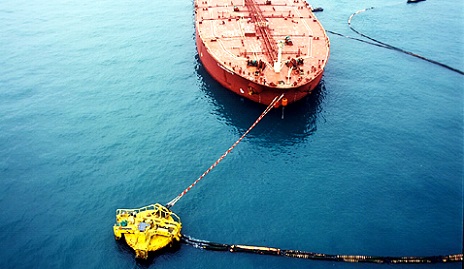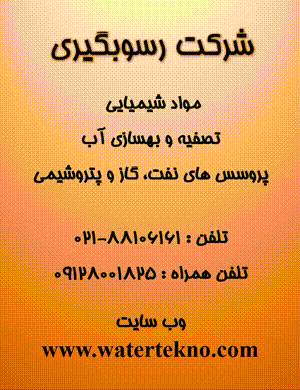آشنایی با Single Buoy Mooring - SBM ۱۳۹۵/۴/۲۱
نام لاتین:Single Buoy Mooring - SBM
کد مطلب:OF-035
آشنایی با Single Buoy Mooring - SBM
SBM یا SPM یک گوی شناور بارگیری مهارشده فراساحلی می باشد که به عنوان یک نقطه مهاری و ارتباطی با شناورهای حمل سوخت برای بارگیری یا تخلیه فرآورده های نفت و گازی استفاده می شود. SPM ها واسط بین اتصالات منیفلد زیر سطحی ثابت و شناور های حمل سیالات نفت و گازی که چرخش دارند مورد استفاده قرار می گیرد.
SPM ها در جاهائیکه تاسیسات و تجهیزات پهلوگیری مناسبی برای شناور های حمل فرآورده های نفت و گاز موجود نمی باشد، قادر به کنترل و بارگیری کشتی ها و شناور های با سایز های مختلف، حتی نفتکش های بسیار بزرگ VLCC می باشند.

Single Buoy Mooring (SBM)
A Single buoy mooring (SBM) (also known as single-point mooring or SPM) is a loading buoy anchored offshore, that serves as a mooring point and interconnect for tankers loading or offloading gas or liquid products. SPMs are the link between geostatic subsea manifold connections and weathervaning tankers. They are capable of handling any size ship, even VLCC (very large crude carriers) where no alternative facility is available.
Parts of SBM
There are 4 parts in the total buoying system: the body of the buoy, mooring and anchoring elements, product transfer system and other components.

1-Buoy body
The buoy body usually is supported on static legs attached to the seabed, with a rotating part above water level connected to the (off) loading tanker. The two sections are linked by a roller bearing, referred to as the "main bearing". The moored tanker can freely weather vane around the buoy and find a stable position due to this arrangement.
2-Mooring and anchoring parts
Moorings fix the buoy to the sea bed. Buoy design must account for the behaviour of the buoy given applicable wind, wave and current conditions and tanker sizes. This determines the optimum mooring arrangement and size of the various mooring leg components. Anchoring points are greatly dependent on local soil condition.
Mooring components
Anchors or piles - To connect the mooring to the seabed
Sinker or anchor chain joint to buoy (SPM)
Anchor chain
Chainstoppers - To connect the chains to the buoy
Hawser arrangement
A tanker is moored to a buoy by means of a hawser arrangement. Oil Companies International Marine Forum (OCIMF) standards are available for mooring systems.
The hawser arrangement usually consist of nylon rope, which is shackled to an integrated mooring uni-joint on the buoy deck. At the tanker end of the hawser, a chafe chain is connected to prevent damage from the tanker fairlead. A load pin can be applied to the mooring uni-joint on the buoy deck to measure hawser loads.
Hawser systems use either one or two ropes depending on the largest size of vessel which would be moored to the buoy. The ropes would either be single-leg or grommet leg type ropes. These are usually connected to an OCIMF chafe chain on the export tanker side (either type A or B depending on the maximum size of the tanker and the mooring loads). This chafe chain would then be held in the chain stopper on board the export tanker.
A basic hawser system would consist of the following (working from the buoy outwards):
Buoy-side shackle and bridle assembly for connection to the padeye on the buoy; Mooring hawser shackle; Mooring hawser; Chafe chain assembly; Support buoy; Pick-up / messenger lines; Marker buoy for retrieval from the water.
Under OCIMF recommendations, the hawser arrangement would normally be purchased as a full assembly from a manufacturer.
3-Product transfer system
The heart of each buoy is the product transfer system. From a geostatic location, e.g. a pipeline end manifold (PLEM) located on the seabed, this system transfers products to the offtake tanker.
The basic product transfer system components are:
-
Floating hose string(s)
-
Flexible subsea hoses, generally referred to as “risers”
-
Marine Breakaway Coupling
-
Product swivel, valves and piping
Risers
The risers are flexible hoses that connect the subsea piping to the buoy. Configuration of these risers can vary depending on water depth, sea state, buoy motions, etc.
Floating hose string
Floating hose string(s) connect the buoy to the offloading tanker. The hose string can be equipped with a breakaway coupling to prevent rupture of hoses/hawser and subsequent oil spills.
Product swivel
The product swivel is the connection between the geostatic and the rotating parts of the buoy. The swivel enables an offloading tanker to rotate with respect to the mooring buoy. Product swivels range in size depending on the size of attached piping and risers. Product swivels can provide one or several independent paths for fluids, gases, electrical signals or power. Swivels are equipped with a multiple seal arrangement to minimize the possibility of leakage of product into the environment.
4-Other components
Other possible components of SPMs are:
-
A boat landing, providing access to the buoy deck,
-
Fendering to protect the buoy,
-
Lifting and handling equipment to aid materials handling,
-
An electrical subsystem to enable valve operation and to power navigation aids or other equipment.
-
Navigational aids for maritime visibility, and fog horn to keep moving vessel alert.
برچسبها
نظرات کاربران
نظر شما



عناوین دانشی صنعت نفت
- مهندسی مخزن | ۱۸
- حفاری و اکتشاف | ۸۰
- بالادستی | ۳۰
- پایین دستی | ۳
- دریایی و فراساحلی | ۶۷
- مهندسی فرآیند | ۷۰
- تجهیزات دوار | ۴۴
- تجهیزات ثابت | ۳۲
- پایپینگ | ۶۰
- برق و مخابرات | ۱۴
- کنترل و ابزاردقیق | ۲۶
- سیویل و سازه | ۱۳
- مواد و متالوژی | ۴۴
- رنگ و عایق | ۷
- ایمنی | ۹
- آب، پساب و پسماند | ۱۲
- مهندسی عمومی | ۵
- رویه و دستورالعمل | ۱۰
- نرم افزارها | ۶
- کلیپهای فنی و مهندسی | ۷۷
- پالایشگاه نفت | ۱۷
- پالایشگاه گاز | ۴۶
- NGL | ۶
- LNG & LPG | ۱۳
- خط لوله | ۳۶
- مخازن ذخیره | ۱۵
- پتروشیمی | ۱۴
- بازرسی و QC | ۱۵
- HSE | ۳۹
- ساخت و نصب | ۱۲
- راه اندازی | ۹
- سازندگان و تامین کنندگان | ۱۰
- تامین مالی و سرمایه گذاری | ۳۲
- ماشین آلات | ۱۲
- مدیریت پروژه | ۹۱
- مدیریت دانش | ۹
- مدیریت سازمانی و عمومی | ۲
- تأمین کالا | ۱۳
- EPC | ۲۰
- پیمانکاران بین المللی | ۸
- اطلاعات انرژی کشورها | ۱۴
- پروژه های خارجی | ۱۵
- نقشه های نفت و گاز خارجی | ۱۰
- شرکت های نفتی | ۱۴
- پلانت های فعال | ۴۰
- طرح ها و پروژه ها | ۳۵
- منطقه های ویژه انرژی | ۶
- میادین نفت و گاز خارجی | ۴
- نقشه های نفت و گاز ایران | ۲۴
- میادین نفت و گاز | ۴۰
- آمار و داده ها | ۷۵
- اسناد بالادستی نفت | ۹
- اقتصاد نفت و گاز | ۶۹
- حقوق انرژی | ۱۰
- دیپلماسی انرژی | ۱۹
- قراردادهای بالادستی | ۲۰
- مهندسین مشاور | ۶۷
- IPC | ۲۰
- پیمانکاری درایران | ۳۶
- نرخ عوامل نفت و گاز | ۱۲
- قرارداد | ۴۵
- ارزیابی اقتصادی طرح ها | ۳
- بخشنامه و مقررات | ۳۸
- مقررات مناقصات | ۳۱
- حوادث نفت و گاز | ۱۰
- ترینهای صنعت نفت | ۱۴
- فهرست بها | ۱۸
- وقایع نفت و گاز | ۵
- پدافند غیرعامل | ۲
- واژگان و زبان تخصصی | ۱۴
- مجلات نفت و انرژی | ۱۹
- مجلات مهندسی و صنعتی | ۴
- مطالب عمومی | ۳۰
- مدیریت منابع انسانی | ۳
- آمادگی آزمون SP | ۳
- آمادگی آزمون RMP | ۴
- آمادگی آزمون PMP | ۶
- انرژی های غیر نفتی | ۵
- آزمونهای استخدامی نفت | ۱۵
- آزمونهای ارشد 94 | ۵۹
- آزمونهای دکتری 95 | ۳۸
- استانداردهای مهندسی | ۲۱
- ابلاغیات | ۹
- بازاریابی و توسعه بازار | ۱
- تحقیق و توسعه | ۶





